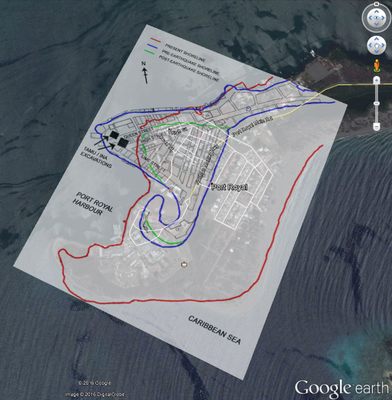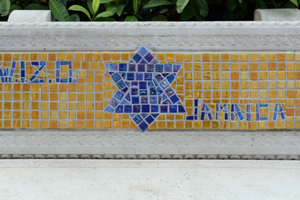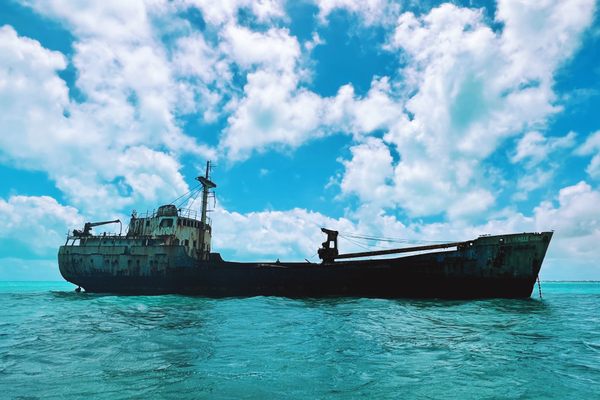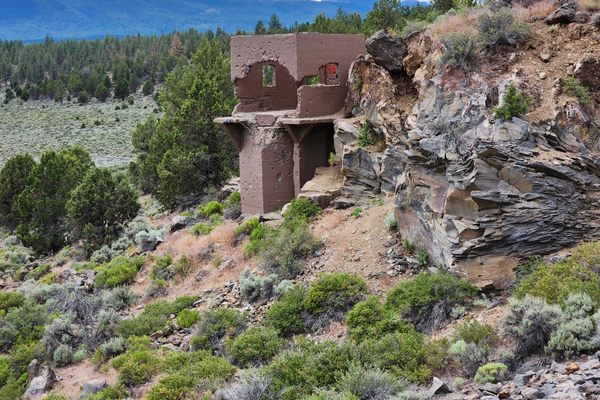About
"The earth opened and swallowed many people, before my face, and the sea I saw came mounting in over the wall, upon which I concluded it impossible to escape."
Edmund Heath, survivor and eyewitness to the devastating 1692 earthquake wrote these words in a letter from the safety of a ship moored in the city's harbor, overlooking the ruins of his city. Port Royal, once called “the most wicked and sinful city in the world” was famous the world over for its booze—the blackout-inducing Kill Devil Rum, its pirates, and its sex workers. Needless to say, when the city was nearly destroyed, there were some parties that saw it as a convenient solution to an ugly problem.
The English and their pirate friends were relatively new to the area. Jamaica had been held by the Spanish since Columbus first declared it “the fairest island eyes have beheld” in 1494. Lacking gold or other obvious exploitable wealth, the Spanish held it but did not focus much energy there. It came under English power in 1655, after Cromwell sent English raiders to invade and capture the Spanish stronghold at Hispaniola (now Haiti and Dominican Republic, then the center of Spanish trade in the Caribbean). Cromwell's men failed spectacularly at taking Hispaniola and turned to Jamaica as a second choice, better-than-nothing option.
Located on the southeast coast of Jamaica, the natural harbor at Port Royal became the center of English life in Jamaica. By the late 1600s it had become one of the largest European cities in the new world, second only to Boston. It had also become the infamous home of pirates, sex workers, and Englishmen on the make. Far from home, they made their livings off of the slave trade, slave labor in plantations, and the money that the pirates brought in from their looting forays against the Spanish.
It may be seen as an indicator of the caliber of vice in Port Royal that in 1675 the notorious pirate Henry Morgan became the Lieutenant Governor. In fact, Morgan began to crack down on overt piracy as the grand era of privateering he had been part of began to enter its waning phase. He died just four years before the earthquake struck and was buried in the Palisadoes cemetery.
On the morning of June 7, 1692, a massive earthquake estimated at a 7.5 magnitude hit the island. The city, largely built over sand, suffered instantly from liquifaction, with buildings, roads, and citizens sucked into the ground. Geysers erupted from the earth, buildings collapsed, and finally the city was hit by tsunami waves, dragging what had not been destroyed out to sea. In the end, some 33 acres of the city disappeared under water, four of the five forts were destroyed or submerged, and 2000 people were killed. The cemetery where Captain Morgan was buried slipped into the sea, its bodies floating up to mix with the freshly dead.
Even before the earth stopped shaking, locals reported that the looting began, one writing: "Immediately upon the cessation of the extremity of the earthquake, your heart would abhorr to hear of the depredations, robberies and violences that were in an instant committed upon the place by the vilest and basest of the people; no man could call any thing his own, for they that were the strongest and most wicked seized what they pleased...."
As news spread of the destruction of Port Royal, it was picked up as a cautionary tale and a sure sign of divine retribution for the lewd behavior of the pirates and sex workers, the pretensions and wealth of the gentry of the town, or the sins of slavery, depending on the city and the audience.
But at any rate, the earthquake did not end Port Royal's wicked ways, nor its relationship with vice or with pirates who continued to stop by for another 50 years while they preyed on Spanish ships. In fact, in 1720, John "Calico Jack" Rackham was hanged at Gallows-Point in Port Royal by order of pirate hunter—and former privateer—Woodes Rogers (best known for his rescue of the castaway Alexander Selkirk, the inspiration for Robinson Crusoe).
Since then the city has been racked by fire, earthquake, and hurricane several times. The English finally decided to close its naval station at Port Royal, effectively closing it for business, and most residents left. In 1951, what was left of Port Royal was hit by Hurricane Charlie, destroying more property and leaving only a few of the original buildings standing.
Today most of the remains of the 17th century city lie under up to 40 feet of water. Up until the 1900s visitors reported on the city still visible below the waves and the eerie sensation of floating over the rooftops. Since the 1950s, divers have been exploring and cataloging the submerged city. In 1969, Edwin Link discovered the most famous artifact: a pocket watch dated 1686, stopped at exactly 11:43.
More recently the Nautical Archaeology Program at Texas A&M University and the Jamaica National Heritage Trust conducted underwater archaeological examinations, ending in 1990. Their explorations have brought to light artifacts of 17th century life rarely seen. Because of the nature of the disaster, which left many buildings intact and more or less undisturbed, it has been compared to Pompeii for its archaeological wonders and was a designated National Heritage Site in 1999.
Special access from the government is required to dive in the restricted Port Royal ruins area, but many of the items recovered over the years can be seen at the Museums of History and Ethnography at the Institute of Jamaica in Kingston.
Related Tags
Know Before You Go
The Museums of History and Ethnography at the Institute of Jamaica in Kingston can be found at Port Royal Collection, Museums of History and Ethnography, Institute of Jamaica 10-16 East Street Kingston, Jamaica (876) 922-3795 www.instituteofjamaica.org.jm At Port Royal (on land): National Museum of Historical Archaeology: dedicated to the history of Port Royal as well as the history of the Jamaican people. Open Mon-Sat 10-5. Fort Charles & Fort Charles Maritime Museum: Originally built by the English as Fort Cromwell after seizing the land from the Spanish, the fort is in good shape largely due to extensive preservation and rebuilding efforts over the years. A plaque reading "You who tread in his footprints, remember his glory" reminds visitors that a young Horatio Nelson was stationed here.
Community Contributors
Added By
Published
July 21, 2016
Sources
- I read 1962 when it should be 1692
- http://nautarch.tamu.edu/portroyal/
- Port Royal, Jamaica, by Michael Pawson, David Buisseret
- http://www.hmsf.org/exhibits/port-royal/earthquake.htm
- http://nautarch.tamu.edu/portroyal/archives/index.htm
- http://www.piratesinfo.com/cpi_Piratical_History_of_Port_Royal_542.asp
- http://en.wikipedia.org/wiki/1692_Jamaica_earthquake
- https://www.google.com/maps/place/Sunken+Pirate+City/@17.9382173,-76.8443227,94m/data=!3m1!1e3!4m13!1m7!3m6!1s0x0:0x0!2zMTfCsDU2JzA0LjkiTiA3NsKwNTAnMjUuOCJX!3b1!8m2!3d17.9347!4d-76.8405!3m4!1s0x8edb6a896fa1e355:0x613113f8b540e78d!8m2!3d17.9383518!4d-76.8441626

































